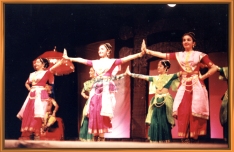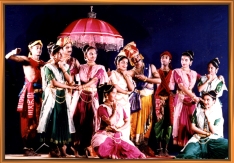

GROUP PRODUCTIONS
SANGHAMITRA - (Samskritam) (1981)
This Samskritam dance drama on a Buddhist theme written by Prof. V Subramaniam of Carleton University (Canada), is based on the transformation of King Ashoka from a war monger to a peace loving king. Prof. Subramaniam is the first composer of dance-drama in Carnatic music on Buddhist themes. It was a revelation for people since Buddhist themes were usually not done in Bharatanaatyam.Originally, as part of a big programme arranged by Prof. Subramaniam in Ottawa in 1976, the Dhananjayans did a single segment from Sanghamitra in its original form, the dialogue between Ashoka and his daughter Sanghamitra. It was very interesting because it was choreographed on only the 2 of them in a short time. The Dhananjayans adapted the play and choreographed it into a mega production on the Bharata Kalanjali dancers with music composed by Turaiyur Rajagopala Sarma.
It was presented for the first time in India in Narada Gana Sabha, Chennai on Feb 6, 1981. A very special presentation of Sanghamitra took place for the First World Buddhist Conference in Delhi in 1984 at the Siri Fort Auditorium. It was choreographed for the International Art Festival of Government of Singapore, with Singapore artistes in 1987. That was its 103rd performance since the premiere in 1981. Sanghamitra has been presented all over India and the US.
Sanghamitra wove elements of music, theatre, mime and Indian folk dance. Using Bharatanaatyam and Kathakali, many innovations were brought in. The choreography in the form of bodyline ornamentation, especially in the Mandapa scene, the lion pillar of Ashoka and the panel description were imaginative. Sanghamitra touched chords in the way the sculptors were depicted.
The theme being a historical event, the colorful costumes and exquisite jewelry were carefully chosen to reflect the grandeur and magnificence of the historical theme and period. The sets and props were specially designed to typify the aura and ambience of Ashoka’s reign.
Originally Shanta did the role of Sanghamitra. This was done later by senior students of Bharata Kalanjali, giving them the exposure and experience of doing major roles in big productions.
Synopsis
Beautifully costumed and choreographed, this dance drama with lyrics in Sanskrit, is the story of Emperor Ashoka, a warmonger, who is transformed into a peace-loving king and disciple of Buddha, by his wise and lovely daughter Sanghamitra.
Ashoka inherits from his powerful grandfather Chandragupta Maurya in 327 BC, a vast empire that stretches across the Indian sub-continent. Yet, not fully satisfied with the size of his kingdom and its riches, he embarks on the task of annexation and the Kalinga War ensues.
The dance drama begins with an invocation to Buddha. Jubilant dancers prepare for the arrival of emperor Ashoka. The victorious Ashoka announces the destruction of Kalinga and citizens celebrate the victory with dance and music.
Meghaveni, the daughter of Ashoka is not convinced. She refuses to accept the ornaments saying they are blood stained. In the ensuing argument, Ashoka describes war as a duty of a king. Meghaveni explicates to him the ravages of war and the misery it has brought to his land and people. Meghaveni asks him and his flatterers, whether one who cannot give life to a being, has the right to kill. Overcome by grief and remorse, Ashoka goes into a daze. His subconscious screams to him that greed is his real enemy.
Ashoka becomes very inactive and depressed. Meghaveni brings Sangharaja (a Buddhist monk) to revive him. Sangharaja convinces the king that Buddhism is not inactivity but waging war against violence and cruelty. Revived, Ashoka orders for the propagation of Buddhism with the erection of stupas and stone inscriptions.
Sculptors build stupas and install the pillars of Dharma Chakra. Citizens declare that their king now rules over two kingdoms, the country and Dharma.
Ashoka plans for propagation of Buddhism in other continents and the Buddhists decide to honor him with the title of “Mahadayaka” (the greatest giver). Meghaveni stops the proceedings declaring that the title is deserved only by the one who has given away his most prized possession, and begs of her father to gift her away to Buddhism. She joins the Buddhist Sangha and becomes Sanghamitra. King Ashoka is declared “Maha Mahadayaka”.
“In contrast to the stark presentation of Ramanaatakam, the sets and costume for this was elaborate. It was usual practice to hire period costumes in those days. We researched into the costumes of Ashoka’s period and avoiding the scantiness, made some nice, beautiful costumes. We also blended some North Indian elements like Kathak in the thillana segments of dance so subtly, that it looks overall like Bharatanaatyam. When we studied the panels of the Sanchi stupa, we saw such movement patterns in the dancing figures and we incorporated these. We used special lighting, and built the Ashoka pillar with human body formation and this novel idea was very well received.”
“We gave a special presentation of Sanghamitra for the World Buddhist Conference in Delhi in 1984 at the Siri Fort Auditorium. Indira Gandhi was scheduled to be present at the program. We were put up at the Gandhi Peace Foundation where there was no phone those days. The day prior to the performance, we received a message at midnight from the Prime Minister’s office that we had an appointment with Mrs. Gandhi at 10am the next morning. We were quite confused and after getting the pass, we were asked by her Security to stand in line. Suddenly, our names were announced and Shanta and I were taken out of the line and into the PM’s office. Her respect for art was so great, she said she was unable to make it for our program that evening, so she wanted to just talk to us for a few minutes. She was so nice; she gave us almost 10 minutes of her precious time and even posed for a photo with us, much to the displeasure of her Security who kept reminding her that time was up! This is an incident we will always remember and cherish.”
SANGHAMITRA - Review - Photo Album
